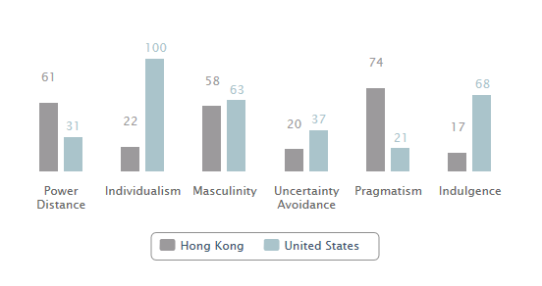Everyone knows that every culture is different, but is there a reason why? How does our geographical location collectively predict our beliefs, customs, attitudes, etc.? It sounds a little odd, but wherever you are, you develop your behavior through social learning. When you socially learn, your observations become part of your actions.
An easy way to predict how a culture socially functions is to observe their standing on the Hofstede’s Cultural Dimension Theory. This theory has seven dimensions that explain the differences found among different cultures. Since I have a fascination with Hong Kong, I will compare their dimensions with ours.
This photo illustrates Hong Kong and America’s driving factors of culture. As you can see, the largest difference we hold is in the Individualism category. This means that in America, we see ourselves as our own person, not as a member of a group. In the contrasting collectivist culture, they see themselves as a member of their family, society and so on.
Having a general understanding of cultural perceptions are important in the Public Relations field because it helps you tailor your message properly. In an individualistic society, your message needs to be factual, relevant to the reader and as clear as possible. But when communicating with a collectivist society, they prefer to receive a message in regards to how it influences their group. When you are cognizant of how people perceive messages, it helps you produce an impactful message.
If you want to compare and contrast the differences between countries, feel free to explore this site!


